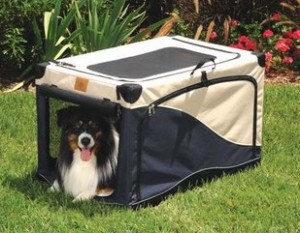When you adopt a new dog, everyone you talk to will give you unsolicited training advice. Visit the dog park/don't visit the dog park. Use a slip collar/don't use a slip collar. It's a lot of conflicting information to work through! When it comes to kennel training a dog, you will also hear a variety of opinions, and it's hard to know what to do.
Personally, I'm a big fan of using a kennel (also called a crate) as a temporary tool to teach the dog how to be calm and well behaved when left alone. My goal is always to get to the point where the dog can safely be left out of the kennel when home alone. For some dogs, that will take a few months. For others, it might take a bit longer.
Reasons to use a kennel:
- A kennel can help a nervous dog feel secure. It's a safe place to hide out, and it takes away some of the dog's pressure about deciding what to do. (Do I bark at everything I hear? Do I chew on shoes? Nope, I guess I just relax in here. Phew!). It can also help prevent separation anxiety.
- A kennel can help prevent accidents because most dogs won't want to eliminate in a small space. (Unfortunately, dogs from puppy mills will already be used to going to the bathroom in their kennels.)
- The kennel reinforces calm behavior. You can help your dog by providing adequate exercise beforehand and then stocking the kennel with chew toys.
- A kennel can help prevent barking.
- A kennel is always a nice option for when you travel to a friend's house with your dog. Some people don't want a dog wandering around the whole house unsupervised. The kennel in the picture above is a travel crate.
Reasons not to feel bad about using a kennel for your dog:
- Most dogs prefer to sleep a lot and won't mind settling in for a nap as long as they've had enough exercise.
- Your dog has a good life! You are the one hard at work while she gets to lounge around at home. Your dog should feel sorry for you!
- You're providing plenty of socialization, interaction and exercise when your dog is not in her kennel.
- Some dogs love their kennels!
- Think of the kennel as a temporary tool for future freedom. If you prevent bad habits now, your dog will get full access to the house with time. It took about six months for my dog to reach this point, but every dog will be different depending on her personality, energy, comfort level when left alone and so on.
How to make the kennel a fun place:
- Keep the kennel in an area where you hang out such as your bedroom or a central room where people gather.
- Feed your dog in her kennel.
- Save extra special toys and treats for when she's in her kennel.
- Never use the kennel as a punishment.
When shouldn't you use a kennel?
There are some examples where a kennel may not be the best option. For example, maybe the dog has a fear of being in the kennel due to past experiences. If that is the case, I still recommend you try leaving the dog in a bedroom or bathroom without access to the whole house. In some cases, using a baby gate to block the bedroom doorway is better than closing the door. It depends on the dog, of course.
Also keep in mind that a kennel should be used within reason. Puppies will obviously need potty breaks every couple of hours. Most adult dogs will do OK for about 8 to 9 hours in the kennel. Ideally, only 4 to 5 hours. Every dog is different, but most do adapt to our work schedules pretty well.
Do you prefer to kennel train your dogs?


